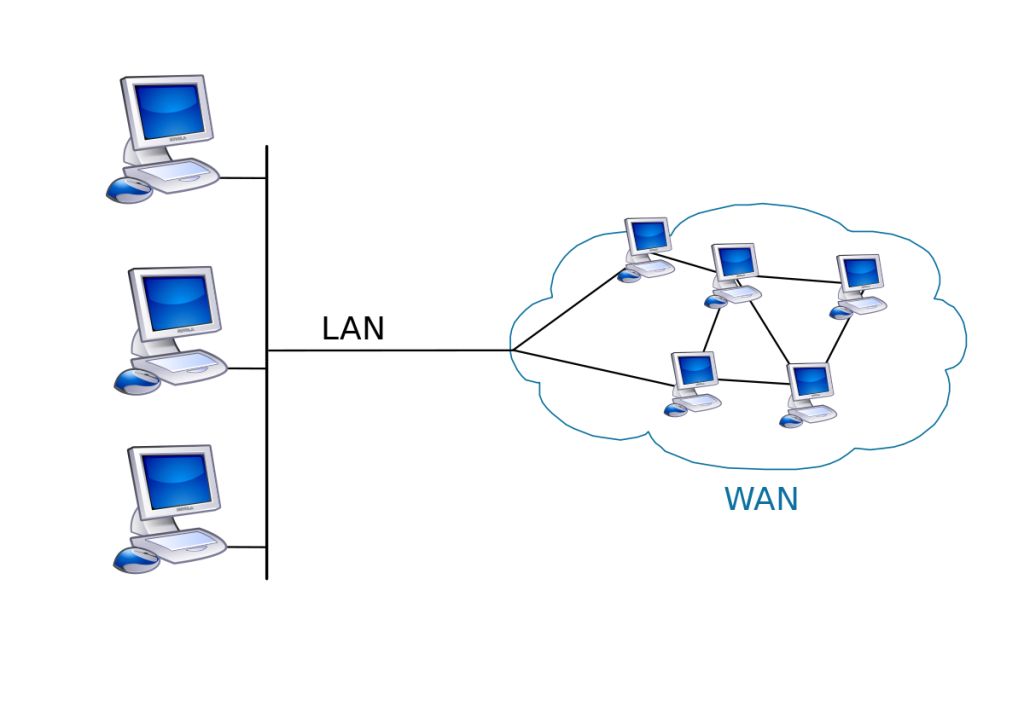Depending on the size of your business, the area network you use will difference between a local access network (LAN) and a wide access network (WAN).
The internet allows businesses to connect with people from all over the world, which expands their customer base.
While the two serve the same basic purpose of linking network devices, you’ll need to carefully consider which will serve your business best. We’ll discuss below what situations are best for each area network and distinguish between LAN and WAN. What you can expect from them.

What is a LAN and Who Does it Work Well For?
A local area network (LAN) is the most common type of area network you’ll find. Many home networks are LANs if they offer ethernet connectivity in addition to wi-fi.
LANs can vary in its exact size, but the key characteristic is that the network serves just one area. Whether your business is just one small office or a larger building with several floors, the network used is a LAN.
LANs typically consist of a modem, router, and access point for wi-fi. Many devices can offer all three services in one unit, which is the easiest way to deploy a LAN.
The modem will provide internet access, while the router allows other devices within your network to communicate with it. Wi-fi is also a nice feature as it eliminates the need for a wired ethernet link.
Area networks are all fairly similar, so LANs mainly differ by only providing interconnectivity to local devices.
This means that LANs are best suited for small businesses and self-employed individuals. They don’t need to have connected access across multiple locations, which makes a local area network the most cost-efficient solution for internet access.
What is a WAN and Who is it Suited For?
Knowing that a LAN serves just a local area, understanding what a wide area network (WAN) does becomes much easier.
WANs are made up of multiple LANs. These LANs are all located in different areas. For example, a WAN could consist of servicing an office in Seattle, another in Los Angeles, and a third in Houston.
To fully understand a WAN, you should also be aware of another network known as a metropolitan area network (MAN). MANs are extremely similar to a WAN, but the biggest distinction is that a MAN connects multiple LANs that are all located within the same city.
With this in mind, a WAN works best for a business that has offices located in multiple different cities and states. This will allow separate LANs to communicate and connect despite the distance in between them.
WANS also tend to use public infrastructure like cable lines. This makes it much easier for the LANs to connect and for clients to communicate with them.
One final difference between LAN and WAN is that the greater size of a WAN usually means that speeds can sometimes be slower. This shouldn’t come as much of a surprise considering that data needs to travel much further within a WAN than a LAN.
What is the Difference Between LAN and WAN?
Knowing the difference between LAN and WAN makes it much easier to determine which will work best for your business. The main question you need to answer is how big your business is and if it is located in multiple locations.
- Generally speaking, a WAN provides far more advantages than just a single LAN does. Public infrastructure makes for cheaper connectivity. Additionally, it offers the ability for employees to access the network remotely, meaning they won’t need to be located in the office to connect to the WAN.
- This doesn’t mean that LAN is completely pointless though. There is a great level of privacy and security within a LAN, providing fewer access points for hackers to infiltrate. While you will need to purchase all components of a LAN, this means that your business will have complete control over it.
- There are certainly advantages to both area networks, but it still comes back down to size. If you have just one office location, stick with a LAN. Alternatively, with offices in multiple cities, you should use a WAN to keep all the individual LANs connected.
Every Business Uses an Area Network
To understand the difference between a LAN and WAN, you must first know what an area network is.
At home, you likely use a home network that provides wi-fi internet for the computers and online devices operating inside your house.
A business office is much larger and requires the use of an area network to keep the whole office connected. These networks typically deal with greater data usage and often included added features like network security.
Closing Thoughts
Regardless of the nature of your business, if you are connected to the internet then you are using some form of area network.
- Local area networks (LAN) service one specific, local area.
- Wide area networks (WAN) connect multiple LANs that are based in different cities.
This makes deciding between the two extremely simple.
Look at the size of your business and determine whether or not you are using more than one LAN already. If you are, then a WAN is a great way to connect them.
Chris Mcdonald has been the lead news writer at complete connection. His passion for helping people in all aspects of online marketing flows through in the expert industry coverage he provides. Chris is also an author of tech blog Area19delegate. He likes spending his time with family, studying martial arts and plucking fat bass guitar strings.